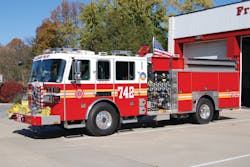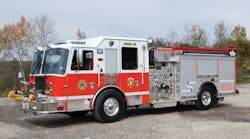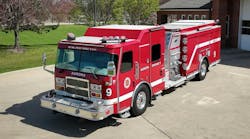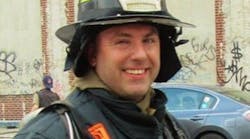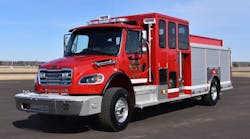There have been many stories over the past few years regarding attempts by fire departments to replace aging vehicles only to be told by higher authorities “there’s no money in the budget for capital expenditures.” After hearing that, fire department officials often look for alternative funding sources such as grants and leases in an attempt to make new-vehicle purchases viable for their municipalities. While there have been some notable success stories (see “The Apparatus Architect – Part 54,” Firehouse®, January 2012), the end result often is that no new apparatus are acquired and fire departments must make do with existing units.
The fire service has come under attack due to staffing requirements, the cost of training new and experienced personnel, overtime and just about anything else that adds to the bottom line of department budget requests. When it comes time to ask for funding for major projects such as fire station rehabilitations and new apparatus, all too often these requests are turned down by municipal officials who reply, “Come back next budget year and we’ll consider the request at that time.”
Unfortunately, our customers – the people we protect – cannot postpone their emergencies until we are properly staffed and prepared to respond. In some circles, the fire department is viewed as a drain on public funds and resources returning little back to support other operations.
Since 2007, the cost of fire apparatus has increased dramatically due to a combination of three factors – emissions standards, safety rules and material costs – that have impacted both the U.S. economy and the fire apparatus industry within a short period. This article will discuss the facts and rumor-fueled fiction that have created a situation in which today the fire apparatus industry is producing nearly 40% fewer vehicles than in any decade in recent history.
Emissions standards
The U.S. Environmental Protection Agency (EPA) promulgated regulations governing diesel engine emissions that took effect in 2004, 2007 and 2010. While each of these regulatory requirements caused the diesel engine manufacturers to change technologies, the ripple effect was for fire apparatus manufacturers to adapt their cab and body designs as well. Between 2004 and 2007, virtually every apparatus builder had to make major engineering changes to cabs or in some cases introduce new cab designs to accommodate the new diesel engine emission standards. The net result was that many new cabs became available, but at a much higher price. When combined with the higher cost of EPA-compliant diesel engines, the average cost of a custom pumper quickly increased by approximately $30,000.
FACT #1
Fire apparatus manufacturers represent a very small portion of the overall number of heavy trucks built each year. As a result, while various fire service organizations maintain associations with lobbyists to work with legislators, our efforts to obtain exemptions from these federally mandated standards have been ineffective.
FICTION #1
“Apparatus manufacturers are making more money with increased profits due to all of the mandated changes.”
This is false. No manufacturer could pass along the total cost of re-engineering its cabs and chassis to fire departments and remain competitive in the market with other builders. While commercial cabs and chassis were cost impacted to a lesser degree, apparatus builders had to devote virtually all of their engineering time meet the new requirements with little time left to develop new products in other areas and little money left for research and development.
Safety rules
The second impact on the cost of fire apparatus was due to changes in the National Fire Protection Association (NFPA) 1901 Standard for Automotive Fire Apparatus Standard, which took effect on all vehicles contracted for on or after Jan. 1, 2009. The NFPA 1901 committee has been at the forefront of promoting firefighter safety, together with the National Fallen Firefighters Foundation (NFFF), to enhance the available technologies on fire apparatus. The 2009 version of the standard included requirements for vehicle data recorders, rollover stability, portable equipment and cab-integrity testing, among other items. While there has been much discussion about the merits of individual requirements, the net result has been safer vehicles for responding and operating at incidents.
FACT #2
Accidents involving engines, tankers and tenders represent approximately 44% of all fatal apparatus incidents. While the fire service has benefitted from well-designed and well-constructed apparatus, in most cases, between 1977 and 2006, 76% of firefighter fatalities that occurred while responding to and returning from calls involved firefighters who were not wearing their seatbelts. These two numbers are staggering and represent areas where all personnel must address their attitudes toward safety and increased training in vehicle operations under all types of conditions.
FICTION #2
“The NFPA 1901 standard makes it more difficult for us to purchase a new apparatus due to the increased cost.” While there can be no disputing the higher costs of new vehicles, the price of a lost-time injury or fatality is incrementally more costly for the department, not to mention the associated impact on members and their families. Departments must take a proactive approach to integrating safety components on new or existing apparatus wherever possible. The NFPA 1901 Standard’s Annex D offers excellent guidelines for departments to consider when upgrading existing vehicles. Purchasing any new apparatus is a costly investment for any municipality. Part 46 of “The Apparatus Architect” (July 2010) reviewed programs and polices that can enable departments to justify purchasing new vehicles.
Material costs
The third cost multiplier for new apparatus is the general state of the economy and the cost of raw materials. Apparatus builders generally do not have the ability to stockpile components such as engines, transmissions and fire pumps to pull off the shelf for use on a particular vehicle. Program apparatus, which are pre-engineered to provide a reasonable number of options, have become an attractive alternative to “start with a blank piece of paper” custom apparatus. The variability on options for major components requires manufacturers to order these specifically for each customer.
The material costs for a custom-chassis pumper can approach half the cost of the completed apparatus. For this reason, the cost of doing business with work in progress and other economic factors dictate that manufactures look to operate with lean manufacturing techniques to reduce their overhead while providing a well-designed and well-constructed product.
FACT #3
The overall quality of fire apparatus has benefited from technology and safety standards. Compare a pumper built in 2010 with one built in 1995 and the number of component and safety enhancements is considerable. While it took the fire service until 1991 to adopt a standard requiring the four-door, fully enclosed cab that was first introduced in 1935, the variety of manual and electronic devices that are integrated into the final design of a new apparatus within the past five years is impressive.
FICTION #3
“My department chooses to waive some of the mandated NFPA 1901 requirements such as the rear-body chevrons and maximum top speed of the vehicle.” As the Authority Having Jurisdiction (AHJ), each department has the final say in determining the configuration of its new apparatus. Most specifications require the completed vehicle to meet all requirements of the current NFPA 1901 Standard as a minimum. Choosing to ignore specific requirements would create problems for the organization if a member or civilian is injured as a result of not meeting a portion of the standard.
While different states and localities have laws that govern the adoption of nationally recognized standards and liability statutes, any department would be well advised to ensure that its new apparatus complies with all requirements of the current 1901 Standard. Several manufacturers can provide third-party certification in this area, which is another manner for the department to ensure that its new apparatus fully complies with the current version of the NFPA 1901 Standard.
Purchasing new apparatus has never been easy and given current economic conditions, departments should protect their investment to ensure that the most appropriate components and safety designs have been engineered into the vehicle. The next edition of “The Apparatus Architect” will review new safety technologies that fire departments should consider on any new apparatus.
For more news and training on emergency vehicle operations, visit: http://www.firehouse.com/topic/emergency-vehicles-and-operation.
